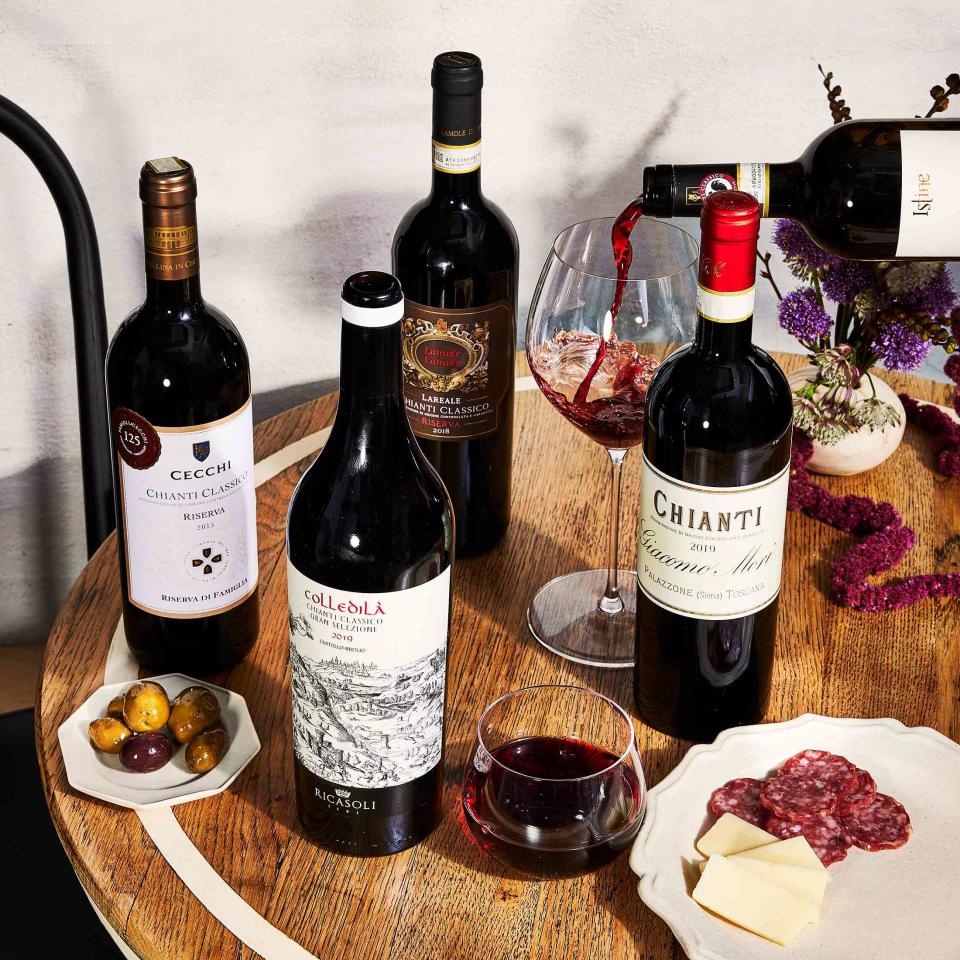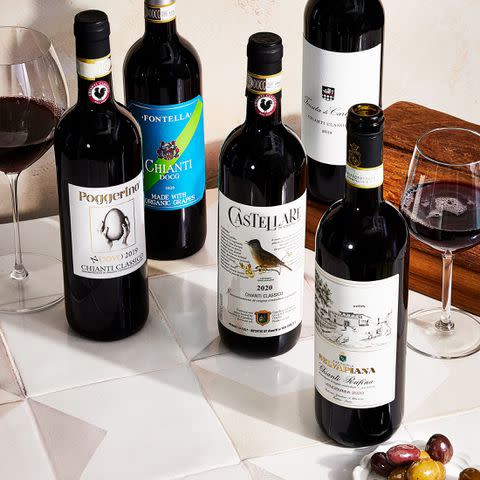Chianti Wine Is a Classic For a Reason
It's never been a better time to stop on this classic Italian red.

Jennifer Causey / Food Styling by Emily Nabors Hall / Prop Styling by Christine Keely
What is Chianti? An inexpensive red wine in a straw-covered bottle, sort of sharp, sort of thin, and not very interesting? Or is it one of the historic wines of Italy, which is now seeing a renaissance in quality along with a string of stellar vintages? If you think it’s the first, welcome to the 1970s; enjoy your disco-and-mood-ring existence, my friend. If you think the second, you are exactly right.
The past several Chianti vintages have been remarkably good. Some of those have been drought years, but as winemaker Andrea Daldin of Lamole di Lamole notes, almost 67% of the vineyards in Chianti Classico, for instance, are now farmed organically, “and organic practices in the vineyard help to reduce water stress in the vine.” That, plus a renewed passion for quality across the region, has led to every vintage from 2015 to now being superb.
The Difference Between Chianti and Chianti Classico
Chianti is divided into seven subzones, the most famous (and arguably the best) of those being Chianti Classico. Basic Chianti wines (designated annata) tend to be crisp, fresh, and straightforward, made for drinking now. As you head up the aging pyramid, the wines gain depth and complexity. Rules vary in each subzone, but in Chianti Classico, for example, Riservas need a minimum of 24 months in barrel and then bottle before release; Gran Selezione wines must spend a minimum of 30 months.

Jennifer Causey / Food Styling by Emily Nabors Hall / Prop Styling by Christine Keely
14 Chianti Wines to Try
2020 Fontella Chianti ($10)
Only organically grown grapes are used for this affordable but lively basic Chianti. Think light, juicy raspberry flavors with a touch of earthiness. It’s an ideal Wednesday night wine, especially with a plate of tagliatelle Bolognese.
2020 Selvapiana Chianti Rufina ($19)
The Chianti Rufina zone is higher and cooler than most other Chianti subzones, giving its wines both elegance and power. Selvapiana’s Francesco Giuntini is a star there, and this round, juicy, steal of a red shows one reason why.
2019 Giacomo Mori Chianti ($21)
Giacomo Mori makes his wines just outside the Chianti Classico zone, so they are simply labeled Chianti. But whereas many basic Chiantis are pleasant and simple, this wine’s fragrant cherry and herb notes lift it into another realm.
2020 Castellare di Castellina Chianti Classico ($27)
Paolo Panerai, founder of Castellare, was a vital force in Chianti Classico’s renaissance in the 1970s, and his wines are still superb. This ruby-hued bottling is round and ripe, with gentle tannins (for Sangiovese).
2019 Tenuta di Carleone Chianti Classico ($36)
Winemaker Sean O’Callaghan first gained fame at Riecine before helping found Carleone in 2012. This red has a kind of herbal-menthol-bay aroma that leads into lifted red cherry fruit— it’s irresistible.
2019 Poggerino Nuovo Chianti Classico ($53)
Earthy aromas lead into red fruit and pepper hints in this red, which is aged in concrete eggs. Piero Lanza, Poggerino’s owner, pays fanatical attention to his vineyards, farming only organically; it shows in his wines.

Jennifer Causey / Food Styling by Emily Nabors Hall / Prop Styling by Christine Keely
2019 Castello di Monsanto Chianti Classico Riserva ($30)
Black tea and forest-floor autumnal notes are the hallmarks of this classically styled riserva. Monsanto is known for elegance, and this has it; the estate is also one of the most gorgeous in Chianti Classico, if you ever have the chance to visit.
2019 Istine Vigna Cavarchione Chianti Classico ($53)
Up-and-coming star Angela Fronti is making beautiful wines right now, and this single-vineyard bottling is no exception. The aroma wafts from the glass, floral and berry-rich, and the wine itself is silky and dense with flavor.
2018 Tolaini Vigna Montebello Sette Chianti Classico Gran Selezione ($55)
Pier Luigi Tolaini, who immigrated to Canada from Tuscany, had a lifelong dream to return and start a winery. In 1998, he did, and now his family makes wines like this intense gran selezione, dense with raspberry fruit and muscular tannins.
2018 Castello di Ama San Lorenzo Chianti Classico Gran Selezione ($75)
Castello di Ama’s wines always have a remarkable purity to them, both young and as they age. Here, that manifests as fragrant raspberry liqueur notes, with a kind of lovely autumnal undertone of dried herbs and spices.
2018 Lamole dI Lamole Lareale Chianti Classico Riserva ($26)
The tiny town of Lamole has some of the highest vineyards in Chianti Classico; as winemaker Andrea Daldin likes to say, “At Lamole, because of the elevation, you are in the antechamber of paradise.” Quite a claim—but there’s no doubt that this mocha-scented, savory red will at least make you very happy.
2015 Cecchi Chianti Classico Riserva ($30)
Although it’s eight years old now, the additional age has only made this riserva all the more appealing. Its old-school austerity is balanced out by its supple black cherry fruit, and it ends on a hint of graphite.
2017 Rocca di Montegrossi San Marcellino Chianti Classico Gran Selezione ($68)
Marco Ricasoli-Firidolfi farms his small estate near Monti organically and uses collected rainwater for much of his winery’s needs. In the hot 2017 vintage, his San Marcellino is full of black currant fruit and plush, caressing tannins.
2019 Ricasoli Castello di Brolio Colledilà Chianti Classico Gran Selezione ($85)
This single-vineyard red suggests a Tuscan forest with its aromas of dried leaves and red berries. It’s polished and gripping, an elegant Chianti Classico that will reward years in cellar, if you don’t drink it this winter.

